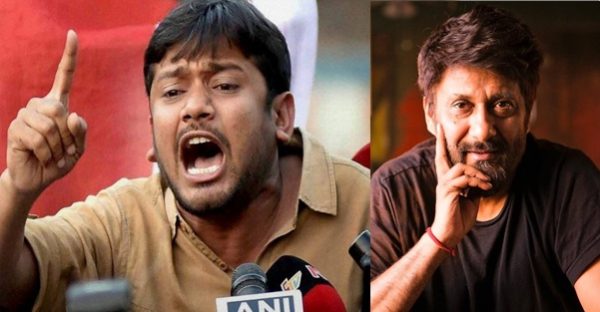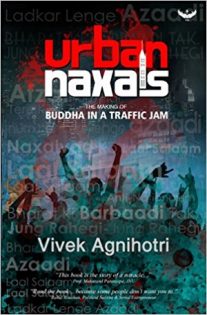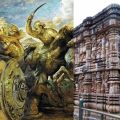Urban Naxals Gang Incessantly Profess Idea of India’s Destruction: Vivek Agnihotri

‘Afzal hum sharminda hein
Tere qatil zinda hain’
‘Tum kitne Afzal maaroge?
Har ghar se Afzal niklega’
‘Bharat tere tukde honge
Inshaallah, Inshallah’
‘Hum leke rahenge azadi…’
‘Afzal, we are ashamed
Your murderers are still alive’
‘How many Afzals will you kill?
An Afzal will appear from every home’
‘India, you ’ll break up into parts
Inshallah, Inshallah’
‘We won’t stop till we get azadi…’
I am watching a viral WhatsApp video where a group of students is screaming these slogans. I think it’s some students in Pakistan displaying their extreme hatred for India. But they don’t look like Pakistanis. Their accent is also different. Is it Kashmir? As the video progresses, I realize it’s neither Pakistan nor Kashmir. In my wildest dreams, I couldn’t have ever imagined that these are the students of Jawaharlal Nehru University (JNU), shouting anti-national slogans, inside the campus, right in the heart of India’s capital. Fifteen kilometers from the Parliament, the temple of democracy.
I stand up. My breathing is getting heavier. I am trembling with disgust. I have never felt such rage ever before. I love India and I am very proud of India. I love students and I am very proud of our students. It was beyond my understanding that the students whom I hold in such high esteem are passionately seeking the breakup of my motherland, my karmbhoomi, my love – India. How can they celebrate a dreaded terrorist who attacked our Parliament?
Is this the beginning of an end? Has the Naxal movement finally revealed itself in urban India? What I see in the video is exactly what we depicted in Buddha. Is the theme of my film taking on a life? I fill a glass with ice and water and gulp it down like a traveler in a desert drinks water. But I am still thirsty.
A couple of days ago, on the cold night of February 9, 2016, an official cultural event had turned into a political rally. The event was against the hanging of Afzal Guru, a Kashmiri terrorist convicted for the attack on Parliament on 13 December 2001 and hanged on 13 February 2013. The event was led by the president of Jawaharlal Nehru University Student’s Union (JNUSU), Kanhaiya Kumar, Kashmiri students Umar Khalid and Shehla Rashid and other student leaders of Leftist parties that are sympathetic to the Naxal movement. Kanhaiya Kumar and his fellow students shouted anti-India slogans including the prayers for India’s break-up and eventual devastation.
Kanhaiya Kumar and his gang get arrested on February 11th on charges of sedition. A ‘war of narratives’ begins in India. Rohith Vemula, a PhD student at the University of Hyderabad, had committed suicide a few weeks ago, leading to widespread Leftist protests around the country, because he was supposedly Dalit – the insinuation was that he had been driven to his death by caste oppression. Anybody who saw these protests in isolation is politically naive because it was just a scene in a screenplay.
It connects now with the Kanhaiya episode. The screenplay started with the Film and Television Institute (FTII), where a section of the students went on strike over the appointment of a new Director; then the IIT Madras row over the Ambedkar Periyar Study Circle (IIT Madras had de-recognised the students’ association after a complaint that it was creating hatred against Hindus. The ban was later lifted.); then Vemula; and now it looks like it is culminating at the citadel of Urban Naxalism – JNU.
Looking at the modus operandi, I can very easily see that Kanhaiya Kumar and the gang is just the front organization for the Naxals. Kanhaiya is being used by the faculty as an ‘intellectual terrorist’ to wage war against the State. They assume that the Modi government is new and not settled as yet, and therefore it’s the right time to strike. In no time, the usual suspects like Barkha Dutt, Arundhati Roy, and all other Naxal sympathizers come out openly in support of Kanhaiya. A civil war-like situation is being created, the government is attacked for suppression of dissent, curbing freedom of expression and for being anti-Dalit. It’s a full-fledged war between the Leftist forces and the State. All front organizations and supporters have come out of the closet. JNU is the battlefield and Kanhaiya their puppet.
In the chaos of the Kanhaiya episode, the media keeps a vital development in the Red Corridor hidden from us. In the last quarter, security forces have achieved greater success than ever in tackling left-wing extremism and there was over a thirty per cent decline in violence perpetrated by Naxals this year.
Seventy-six Naxal cadres were killed in the first few months of this year in comparison to fifteen in the same period last year. According to the Home Ministry, as many as six hundred and sixty-five Naxals were arrested and almost the same number surrendered as compared to just above hundred last year in the same period.
Almost at the same time, the Home Ministry cracked down on a number of NGOs which got foreign funding in the past couple of years. In the second half of 2015, the Indian government cancelled registrations of more than ten thousand NGOs across the country, including Greenpeace. With the increasing fatalities, arrests, and surrenders of the cadre, the tightening grip of the security forces, decrease in funding through NGOs, the Naxals have been feeling the heat, hence FTII, Vemula, and Kanhaiya seem obvious and logical tactics.
I heard Kanhaiya’s speech and it took me back to my college days when student politics wasn’t as sophisticated and well-oiled. When media professionals had not become brokers. It wasn’t limited to ideological confrontations but also involved desi katta, swords, guptis, hockey sticks, crude bombs and Rampuriya chakoos. In the midst of all this there were speeches and sloganeering by the student leaders and their mentors from either Congress, Akhil Bharatiya Vidyarthi Parishad (ABVP) or Leftist parties.
Those speeches were mostly about how to make the university a better place for students. Only leaders from Leftist parties used to gives speeches which were about a utopian social engineering, and freedom from the State. Listening to Kanhaiya, I felt as if I was listening to a pop version of speeches I heard decades ago. Barring Kanhaiya’s personal mannerisms and dialect, his speech was straight out of a Communist template. A narrative which hasn’t changed a bit with the changing times.
It appears that Communists have a ‘speech template’ and all their leaders are given training in speaking the same way. The strategy is simple: take an unattainable, high moral ground, raise concerns over all evils of society, divide people but never present a plan to eradicate these evils. They have mastered the art of creating a fake narrative. In any society, there are always some people who are perpetually dissatisfied with everything. To an extent that even if you give them azadi, they will find problems in that too. From my student days until Kanhaiya, they have been fooling people without suggesting any solutions. Ask Kanhaiya how he will get us azadi from poverty and Manuvaad and Brahmanism and I am sure he will shift the goalpost. This is why I do not trust Leftists. They only raise questions. Never give answers.
………
Another reason I do not subscribe to the Communism of Kanhaiya is that Communists practice violence. Tens of thousands of innocent people have been killed in Naxal-infested areas and millions remain poor and oppressed. Your comrades do not allow TV in tribal areas as it can instill greed in the Adivasis. They would want to make money and the only antidote to your poison is money. Communism is not an ideology, it’s an economic system, but the mentors of Kanhaiya fool people by projecting it as an ideology. Liberalism and even Fascism are ideologies but Communism is not. That’s why I don’t subscribe to this erroneous politics.
Communism is really good only as textbook material. In practice, it destroys societies and their spirit. Look around the world and you will find that wherever Communism reached, people lost their freedom. Their voice. Their lives. First, it makes you angry, then hapless and then a victim. It does not allow dissent or debate. Communism’s only contribution is that it has encouraged poverty, mediocrity and violence. I shun such hypocrisy.
Kanhaiya represents aspirations of just a few thousand students of JNU. Even they will flip once they have to earn their bread and butter. India is too big and has millions of real students who actually want Azadi from such negativity, pseudo-intellectualism, and broker–ship. Students who want to be proud of their nationality, their Constitution, their government, their people, and their culture– Kanhaiya does not represent their aspirations. He is not a genuine–youth icon. He is a trained, well-funded student leader on hire. By calling him a youth icon, you are insulting millions of Indian youth/students who at this very moment are studying hard and getting prepared to create wealth and repay their motherland by getting her Azadi from poverty and ‘traders of poverty’.
I feel as if someone has taken the script of Buddha and is playing it in real life. The only difference is that in the end, unlike Kanhaiya Kumar, my hero Vikram Pundit, instead of destruction of India, professes the idea of reconstruction of India.
As I hear Kanhaiya Kumar and his gang chant slogans like ‘Bharat se azadi…. Le kar rahenge azadi…. Brahmanvad se azadi…bhookmari se azadi’ (Freedom from India… from Brahminism…from hunger) in this viral video, I want to ask him how he envisages such azadi will be brought about. I am sure he has no ideas and that’s where Buddha comes in, which shows an alternate way to find azadi from poverty and oppression. My resolve to release the film has become stronger and absolutely unconditional. Because I know that Buddha’s time has come.
Buddha must win.
The above post is an EXACT EXCERPT from the book Urban Naxals authored by Vivek Agnihotri, award wining Film-maker and published by Garuda Prakashan.

Click here to buy Urban Naxals.
Film-maker Vivek Agnihotri writes of his journey in making the film Buddha in a Traffic Jam which exposed the nexus between an India-wide Maoist terror movement and their supporters in urban centers such as academia and media. Naxalites are waging war on India with details plans for an overthrow of the State. Urban Naxals act to amplify their message, serve as recruiters and wage a propaganda war through social and conventional media. This gripping story recounts Agnihotri’s own grooming in College to be an Urban Naxal and details the plans and modus operandi of the movement. Agnihotri’s story is a behind-the-scenes look at the making of Buddha in a Traffic Jam, the violent resistance to its screening, and an expose of the world’s largest extreme-left terror movement and its penetration into urban India.
Vivek Agnihotri’s book Urban Naxals is scheduled to be launched in major cities across India in May and June.
Kanhaiya image courtesy: The Indian Express.
Disclaimer: The views expressed here are solely of the author. My India My Glory does not assume any responsibility for the validity or information shared in this article by the author.






